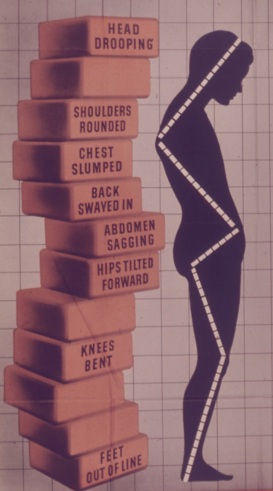As mentioned in an earlier post, our modern day sedentary lifestyle is taxing to our bodies in many ways. Prolonged sitting, inactivity and less and less physical challenges make for low body awareness, atrophied muscles and many cardiovascular conditions. A particularly noticeable outcome of this is a general prevalence of poor posture.
In short: poor posture is an epidemic.

If you happen to be in a place full of people, just have a look around and observe peoples’ posture while they are sitting and working or even when they are standing or walking. How is the position of their neck and head? How about the curves of their spine? Do the shoulders slouch forward? Are the feet directed forward or do they turn in or outward?
Chances are high that you will be able to observe many things that reveal some severe imbalances in peoples’ muscular-skeletal system, resulting from long years of bad habits and poor movement patterns.
Many people suffer from what is sometimes called the “crossed posture syndrome“.
Have a look at this short video that is introducing the crossed posture syndrome.
Now, why is it that so many of us have poor postural habits?
On one hand, it certainly has to do with the modern day tendency to spend large amounts of time sitting (often in horrible positions), slouching forward, while we are working, writing, eating or watching TV – starting from a very young age, which results in the observation of horrendous muscular imbalances and movement deficits in many children already at primary school level.
Another big factor is stress, since the stress response activates a series of physical mechanisms that can contribute largely to poor posture if they are turned on constantly.

The problem with poor posture is not only that it looks really bad in the mirror and to other people, but also that it can lead to a host of serious health complaints and affect our bodies and minds in a variety of negative ways.
First of all, as mentioned above, some muscles will get hyperactive and tight whereas others will get chronically weak and long.
Undue stress is put on the spine and other joints when the surrounding muscles get out of balance and when pain sets in, the body tries to find ways to ease it, which can lead to even worse posture. Not only will there be increased strain on certain joints, but the imbalances also make for a decreased range of motion (=inferior movement) and an increased occurrence of painful trigger points and tightness in the body.
Look at this informative video of Chicago chiropractor and movement specialist Dr. Evan Osar on posture and sitting:
In short: bad posture is bad news!

But, there are also a lot of myths about posture, have a look at some of them in this link to an article of the Huffington Post:
And here another document listing 10 popular myths about posture.
Now, there are several things we can do to do our bodies good and start improving our posture. Generally, this can be summarized into at least four points:
- Postural awareness and training
- Stretching of the tight muscles
- Strengthening of the weak muscles
- Soft-tissue work to release trigger points and restore normal health/functioning (this can be professional massage treatment or self-massage with tools like foam rollers)
At this point, it is worth mentioning that also around the topic of posture and postural correction there are a lot of different opinions and approaches – as with many topics related to health and well-being. However, the information provided here seem sensible and widely recognized.
First of all, we need to become aware of our postural habits throughout the day and also become conscious of where our problems lie.
Here is a great informative blog post by performance coach Keats Snideman from Arizona, USA, on posture and postural assessment (I can also only recommend his “The other 23-hours-series on his blog which includes posts about various related topics like stress, sleep, posture, microbreaks, rest positions, massage and stretching).
After initially becoming aware of our problems and reminding ourselves throughout the day, we need to then relearn how to move in a more functional and healthy way and there are many different methods to do this, some focus more on relearning certain movement patterns and strengthening weak muscles through specific exercises, others more on awareness and proper alignment during exercises and everyday activities (like Feldenkrais and Alexander Technique).
To help balance out our muscular imbalances, most trainers recommend some sort of a corrective exercise program that helps strengthening weak and stretching out tight muscles.
Maybe most importantly, we have to start adopting better posture during all of our activities during the day, which can be assisted by a corrective exercise program that helps weak muscles to become stronger and tight muscles to become suppler. If we happen to sit a lot in our jobs or studies, we need to find a good, ergonomic way to sit on our computers or desks, as well as adopting the habit of taking frequent breaks from sitting, possibly including some short exercises that can reverse the bad effects of our prolonged periods of sitting.
Have a look at this video, explaining how to have better posture when sitting and working at the computer in an illustrative way:
On the same note, I’ll share an infographic by I found that contains 7 steps to better posture while working. Have a look (click on it for bigger size)!

To provide some further good video and reading material to delve deeper into the topic, I will conclude this blog post by providing several links to videos, pictures and websites that focus on this topic.
First of all, I’d like to recommend two youtube channels that provide a lot of videos on correcting posture.
One channel is by Indiana (USA) based chiropractor Steve Hoffman who provides a lot of videos on improving posture and movement as well as other information like nutrition and wellness. One of his videos was already embedded above.
https://www.youtube.com/user/posturedoc
Here one more detailed introductory video on the crossed posture syndrome by Dr. Steve Hoffman.
And, another very good and informative youtube channel almost exclusively dedicated to posture related topic is the “posturevideos” channel by US chiropractor Dr. Paula Moore.
http://www.youtube.com/user/posturevideos
Look here at the great introductory video series “7 Biggest Posture Mistakes”:
Furthermore, I found another good infographic on the topic that I’m sharing below. Have a look at it and learn more interesting facts related to the topic of posture.

OK, I hope this served as a helpful introduction to the topic and as a motivation for all of us to become conscious of and start to improve our posture. Please share this information and if you discovered that your posture is less than optimal while reading this post, don’t despair (it’s the case for most of us) and don’t be too hard on yourself (look at the effects of feeling bad about oneself in the comic below :-)), but start to be active NOW and soon enjoy the benefits!

